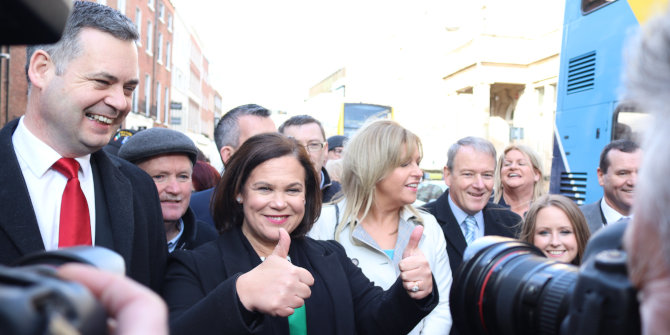 Sinn Féin experienced a late surge in popularity to secure the largest share of the vote in the Irish general election on 8 February. John Ryan writes that the party’s success has redrawn Ireland’s political landscape, leaving the country’s two established parties of power, Fianna Fáil and Fine Gael, in a difficult position.
Sinn Féin experienced a late surge in popularity to secure the largest share of the vote in the Irish general election on 8 February. John Ryan writes that the party’s success has redrawn Ireland’s political landscape, leaving the country’s two established parties of power, Fianna Fáil and Fine Gael, in a difficult position.
The Republic of Ireland’s general election took place on 8 February. Sinn Féin’s vote share increased by 10.7 percentage points, making it the most popular party. This is the first time it has achieved this distinction; it will not be the largest party in the Irish Parliament (Dáil Éireann) only because it did not run enough candidates to capitalise on its surge in popularity. In 2019, it had very poor local and European Parliament elections, losing half of its local councillors, which is making its success in the general election even more surprising.
The result is part of a story that began more than a decade ago, with the economic crisis, spending cuts and tax increases, and the intervention of the IMF and EU with a multi-lateral ‘bailout’ loan in late 2010. Fianna Fáil and the Green Party, which were in government at the time, were severely punished by the electorate at the general election in 2011. Having continued with a programme of spending cuts and tax increases from 2011 onwards, Fine Gael and Labour also lost swathes of voters in 2016, notwithstanding Ireland’s rapid economic recovery.
From 2016, Fine Gael governed with the support of a confidence-and-supply agreement with Fianna Fáil, which effectively supported the government in parliament. This arrangement lasted almost four years – long beyond its expected lifetime – partly due to the need for political stability to deal with the impact of Brexit.
Ireland’s political landscape has now been redrawn. Sinn Féin has won the popular vote in the Irish election, securing 24.5 percent of first preferences in the country’s electoral system of single transferable votes. Opposition party Fianna Fáil came second with 22.2 percent, and Leo Varadkar’s ruling Fine Gael a dismal third on 20.9 percent. As far as seat distribution is concerned, Fianna Fáil received 38 seats, down 6 seats on 2016. Sinn Féin won 37 seats, up 14 on 2016, and Fine Gael dropped 16 seats to end up with 35 seats. This means that Fine Gael had the third worst vote result in its history (after 1944 and 1948), while, for Fianna Fail, it was the second worst ever (after its post-crash humiliation in 2011).

Pearse Doherty and Mary Lou McDonald, Credit: Sinn Féin (CC BY 2.0)
Under the mechanics of Ireland’s electoral system, 39 constituencies elect between three and five lawmakers each, through a single transferable vote. Sinn Féin’s election success materialised under the leadership of Mary Lou McDonald, a Dubliner who replaced veteran Belfast leader Gerry Adams in 2018. Since the party only put forward 42 candidates to fill Ireland’s 160 parliamentary seats, and since its success has come at the expense of other left-wing parties, it may now be impossible to build a governing bloc.
Sinn Féin rode a wave of anger over homelessness, soaring rents, hospital waiting lists and fraying public services. McDonald offered left-wing solutions, such as an ambitious public housing building programme, that enthused voters, especially those under 50. Meanwhile, Varadkar’s attempt to frame the election around his Brexit diplomacy and the strong economy fell flat. Fianna Fáil was contaminated by its confidence-and-supply deal that had propped up Varadkar’s minority administration, leaving Sinn Féin to cast itself as the agent of real change.
Varadkar may have a reputation abroad as a modern and polished statesman, but his domestic image differs from this substantially. Unusually for an Irish politician, the prime minister is socially awkward, and has not emerged as the ruthless vote-winner his party hoped he would be when they chose him to replace Enda Kenny in 2017. Simon Coveney, the Foreign Affairs minister, is being sounded out by Fine Gael members about taking over from Varadkar. Coveney was runner up in the party’s 2017 leadership election.
This extraordinary election result comes at a time at which the Republic of Ireland is the fastest growing economy in the EU, whose right of centre Taoiseach (prime minster) is a competent, gay, mixed-race Irish-Indian. Sinn Féin at its core is the party that wants to call a border poll in Northern Ireland and the Republic of Ireland on Irish unity. At the same time, it embraces multiculturalism, and supported both gay marriage and abortion rights. Relations with the UK were, until Brexit, as close as they have ever been. But Brexit altered the mood. Irish people disliked the way Brexiters disregarded Irish concerns.
Brexit itself may in fact have become Sinn Féin’s perfect storm: Not only has it locked the two larger parties into an extended problematic marriage, but it has also left the prospect of a United Ireland looking far less remote. Northern Irish voters chose Remain in the 2016 referendum but are now outside the EU anyway. Faced with the choice between two unions — the UK or the EU — many north of the border may choose unity with the Republic of Ireland in the next five years. Irish unity is Sinn Féin’s raison d’etre; already sharing power in Belfast, the party promises to hold a unity referendum within five years if it gains control in Dublin.
The two established parties of power in Ireland find themselves in a difficult situation. Varadkar has ruled out a pact with Sinn Féin and has instead floated a deal with Fianna Fáil. During the campaign, the Fianna Fáil leader, Micheál Martin, ruled out entering government with Sinn Féin but left the door open to a deal with Fine Gael. Some suspect its preferred outcome is a Fianna Fáil-Fine Gael government – an unpopular continuation of the status quo that would consolidate Sinn Féin as leader-in-waiting of the subsequent government. If Fianna Fáil and Fine Gael are unable to come to an understanding to form a government, then a new election would be called, in which Sinn Féin would almost certainly run more candidates and win more seats.
On 20 February, Seán Ó Fearghaíl of Fianna Fail was re-elected as speaker which means Fianna Fail have 37 seats, the same as Sinn Féin. Four party leaders failed to win enough support to be elected Prime Minister (Taoiseach) in the first sitting of the 33rd Dáil, with Sinn Féin leader Mary Lou McDonald winning the most votes. In the first vote, members of parliament voted against Fine Gael leader Leo Varadkar being re-appointed as leader of the country and he offered his resignation to President Michael D Higgins. He will continue in the role in a caretaker capacity until a new Prime Minister is elected. The result was 36 votes in favour, 107 against, with 16 abstentions.
Members of parliament also voted against Fianna Fáil leader Micheál Martin’s bid to become Prime Minster, as 41 voted in favour, 97 against and 19 abstained, and then voted on Green Party leader Eamon Ryan’s attempt to become Taoiseach, but he only received the support of his party’s 12 TDs, with 115 votes against and 28 abstentions. Sinn Féin’s Mary Lou McDonald failed to win enough support, with 45 votes in favour, 84 in opposition and 29 abstentions. The Irish Parliament has adjourned until Thursday 5 March and the talks seeking to agree a programme for government are set to intensify, a process that could take weeks or even months, and end in another election.
Sinn Féin is now poised to recast Ireland’s political dynamic and install itself as a third large party in what has historically been a two-party system. Whether in government or opposition, 2020 will be the election that sees Sinn Féin fundamentally break the historical tight grip of the two traditional parties on Irish politics.
Mary Lou McDonald is a smart politician, careful not to box herself in to policy positions that she cannot get out of or cannot sell to the party faithful. So while she now talks about reunification and the need for a border poll – she also stresses the need for a process of preparation for constitutional change and for orderly transition, without attaching a time scale to it.
________________
Note: This article was first published on LSE EUROPP – European Politics and Policy.
 John Ryan is a Fellow at LSE IDEAS at the London School of Economics and Political Science and a Network Research Fellow at CESifo, Munich, Germany. He previously was a Fellow at St Edmund’s College, University of Cambridge, and the German Institute for International and Security Affairs, Berlin, Germany.
John Ryan is a Fellow at LSE IDEAS at the London School of Economics and Political Science and a Network Research Fellow at CESifo, Munich, Germany. He previously was a Fellow at St Edmund’s College, University of Cambridge, and the German Institute for International and Security Affairs, Berlin, Germany.







